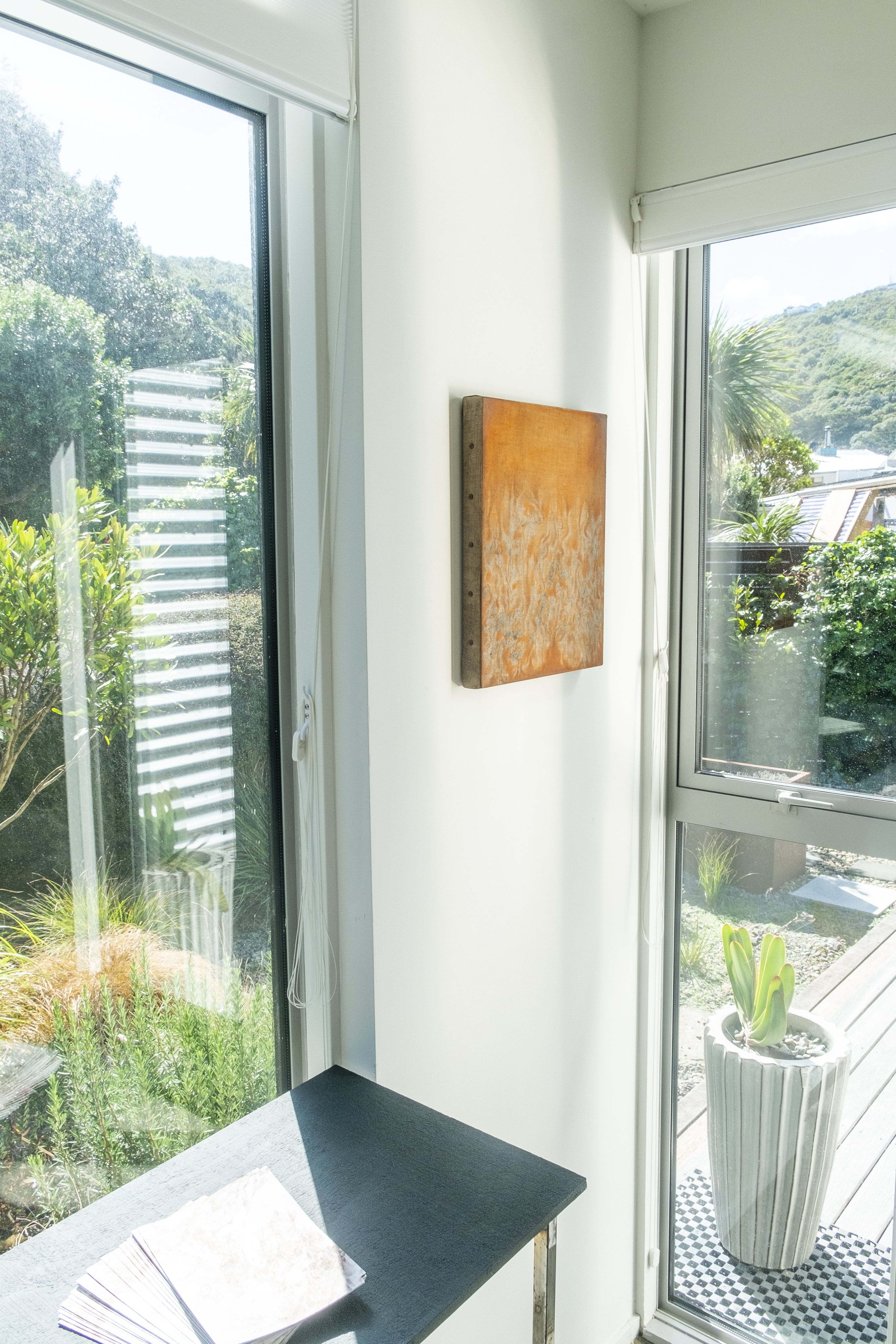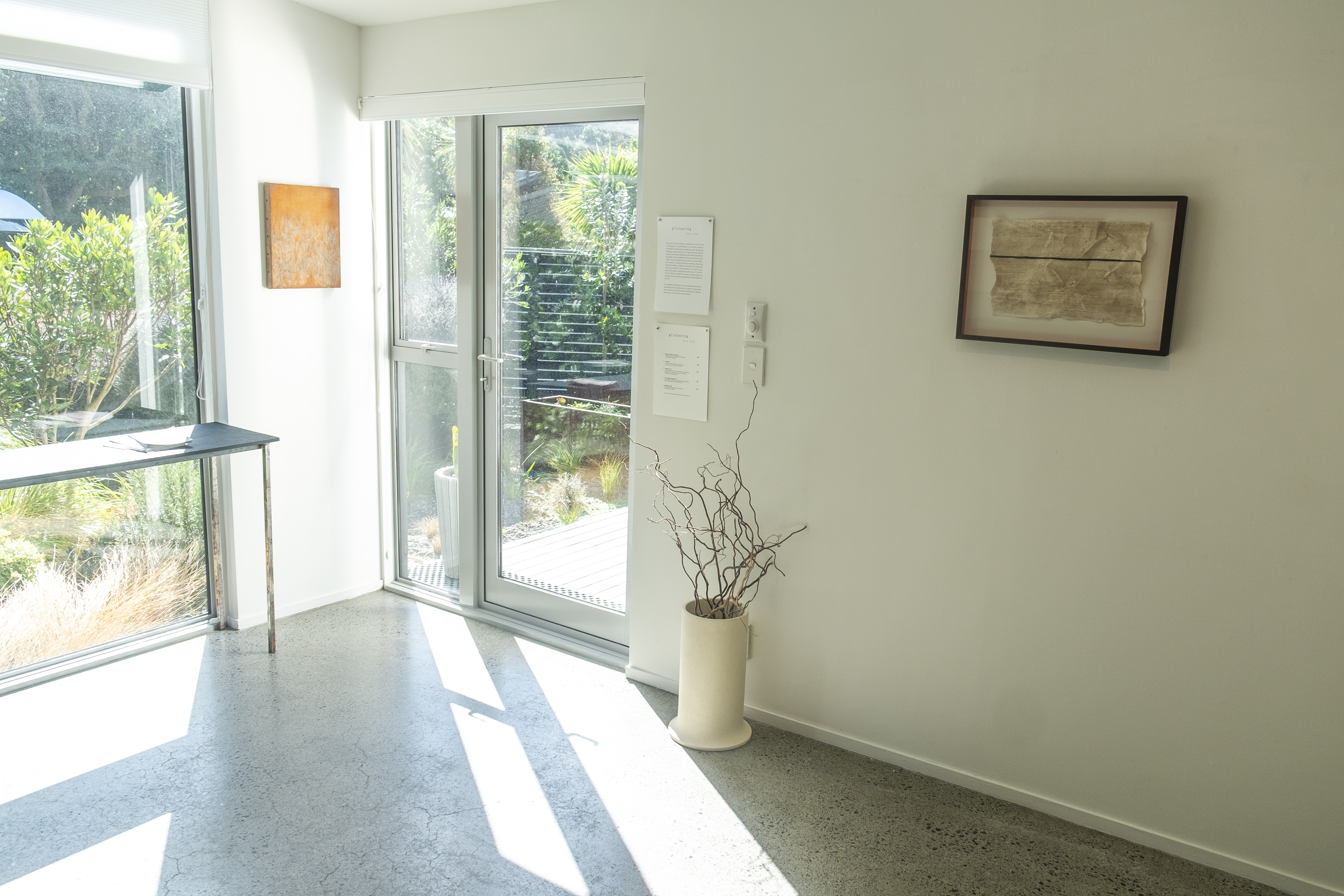Phosphorous Veins
mud and oil on stretched hemp with rusty nails, 380x300mm





Where a lake longs for its edges
Chloe Mason
Boggy Pond is separated
From Lake Wairarapa’s edge.
Defined by the control of water
And scattered with willow remnants.
Farm runoff and poaka
Harakeke and phosphorus.
Sediment and green algae smother the surface
Blocking sunlight and preventing reflections
Of nodding grass
And pūtangitangi
And the blue vault of sky above.
Bound together with plants
In a restless marriage.
Feeding on
And feeding into
The body of the wetland.
A dense thicket
Of plant and word
Painting and swamp
Tea coloured waters and tī kōuka flowers.
Though appearing languid and restful
It is already different.
Contents ever-changing
Substance never quite still.
Earth holds water
Water works through soil
Absorbing, filtering, providing
Residence time.
Encircled by stopbanks and road
Had Boggy Pond remained borderless
It might go by unnoticed
The moment you left farmland
And waded into its belly.
Chloe Mason
Boggy Pond is separated
From Lake Wairarapa’s edge.
Defined by the control of water
And scattered with willow remnants.
Farm runoff and poaka
Harakeke and phosphorus.
Sediment and green algae smother the surface
Blocking sunlight and preventing reflections
Of nodding grass
And pūtangitangi
And the blue vault of sky above.
Bound together with plants
In a restless marriage.
Feeding on
And feeding into
The body of the wetland.
A dense thicket
Of plant and word
Painting and swamp
Tea coloured waters and tī kōuka flowers.
Though appearing languid and restful
It is already different.
Contents ever-changing
Substance never quite still.
Earth holds water
Water works through soil
Absorbing, filtering, providing
Residence time.
Encircled by stopbanks and road
Had Boggy Pond remained borderless
It might go by unnoticed
The moment you left farmland
And waded into its belly.
Seeds float with the wind
Across a biological threshold.
Creatures visit from either side
Wary of those residing here
Like the matuku who find shelter
In the whispering raupō.
At the edge there is a lesson.
To stare down the wild
Is to witness in fragments
Is for the wild to slip away
To retreat into the tall grass
To sink beneath sludge.
One must broaden their peripheral
To drink in a sight
So it swells in a great arc
Pouring through the eyes rim
Where the seen and unseen
Confined and permeable
Empty and abundant steep.
When land transitions to water
Where a lake longs for its edges
One might choose to roam.
To slosh through water
Using wingspan to balance
And make yourself available to a view.
Whether it is the matuku
Or a painting
Or the ooze of soft mud
Or the entire saturated, purei-filled world.
This work was made by responding to the marks made on the hemp substrate by Boggy Pond, clearly demonstrating collaboration in its making. Additionally, the application of orange oil paint seems to flow through the gaps between the muddy marks, imitating a birds-eye view of a wetland, where water both ebbs, flows, and stagnates, becoming a transitional space for water and land to converge – for my making to converge with Boggy Pond’s. The title refers to the high instance of phosphorus in Wairarapa Moana and its wetlands, which make it “supertrophic” – a high trophic level that indicates poor water quality. This has been heavily influenced by agricultural run-off. In Phosphorous Veins, the orange is representative of colours present in the wetland, but also of a pollutant. The rusted nails in the painting’s sides mimic this colour, while also hinting at the agricultural use of nails in fenceposts that mark the boundary of Boggy Pond.